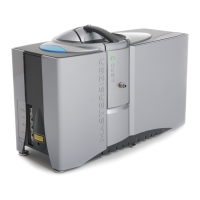Making measurements Chapter 4
Mastersizer 3000 Page 4-7
Click on an SOP to display its properties in the bottom panel of this window.
3. After selecting an appropriate SOP, click OK.
4. The Measurement Display window is shown. The progress bar at the top of
the window reports both the current status and what to do next.
Result view panel
The Result view panel contains the Laser, Light Scattering and Size Dis-
tribution panels. The information shown is either live or, after a measurement
has been completed, relates to the currently selected record (the bold yellow
line) - this record number is shown at the top of the Result View panel.
Laser - the Laser display panel initially provides an indication of the cur-
rent Power output of the laser, and then, during the sample addition phase,
with the current obscuration level. When adding sample it is vital that the
obscuration falls within the green band - this band is defined by the user in
the Measurement obscuration section of the Manual measurement settings
window.
The Trend view show in the bottom half of the Measurement display illustra-
tion is only available with the Mastersizer 3000 / Mastersizer 3000E with
Extended software option.

